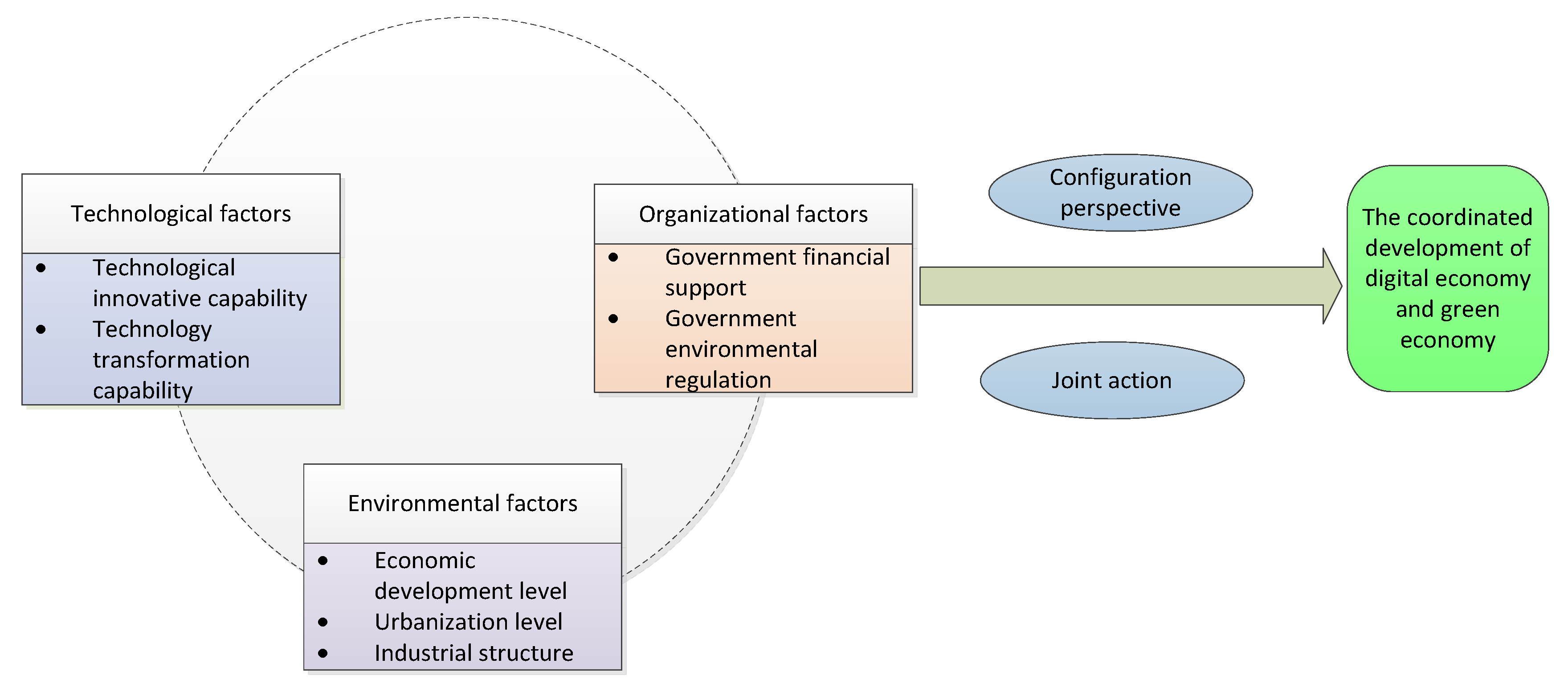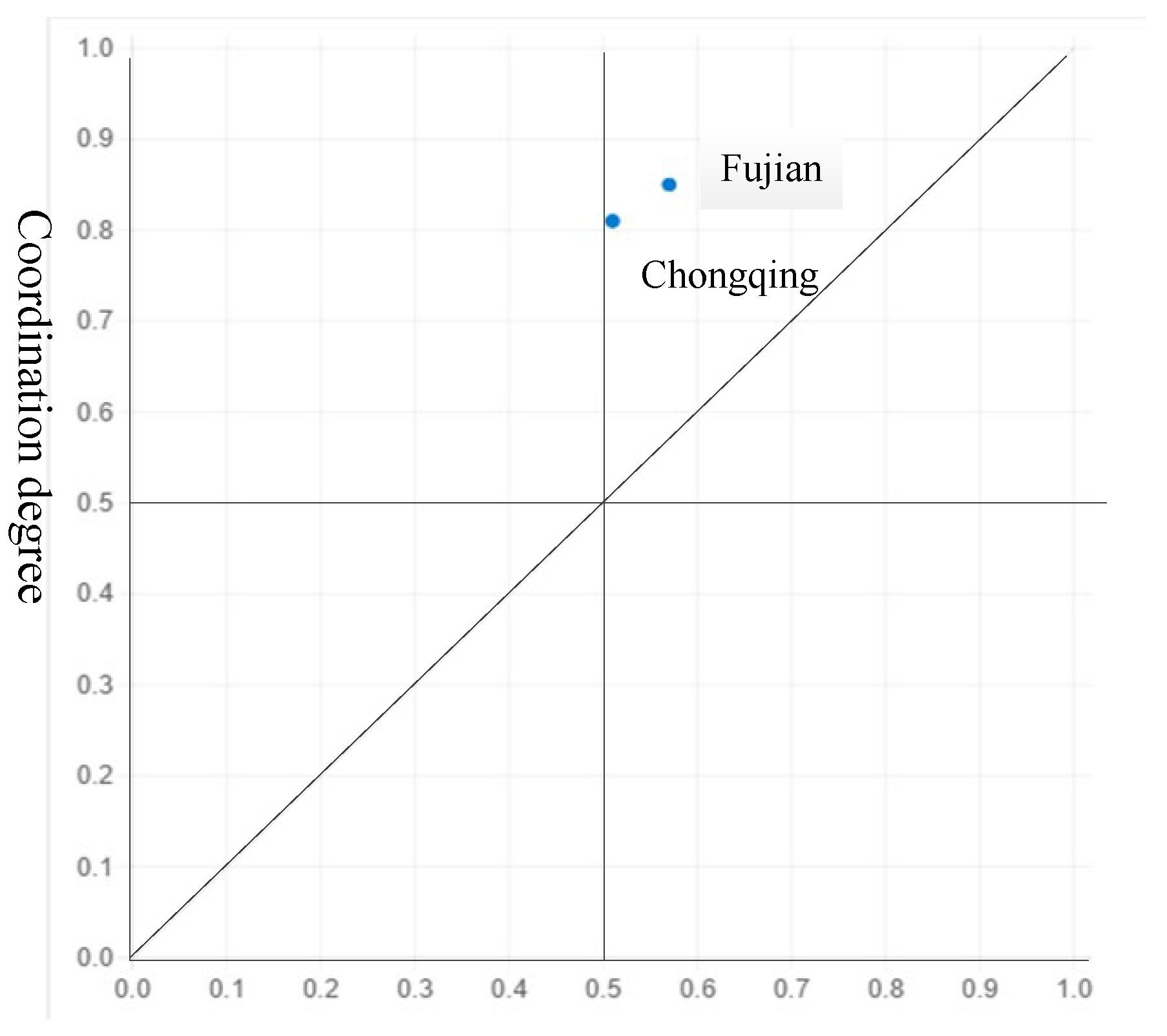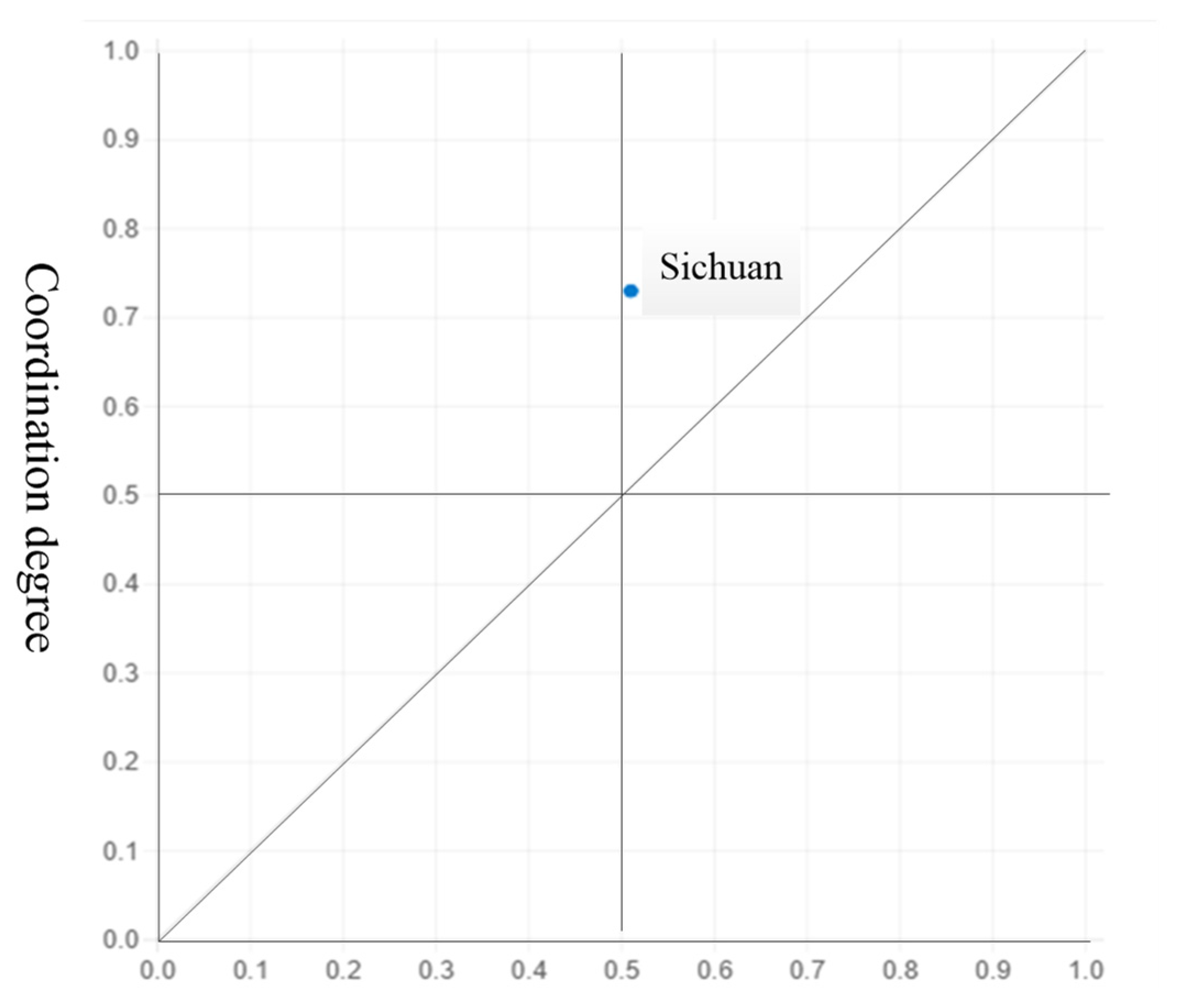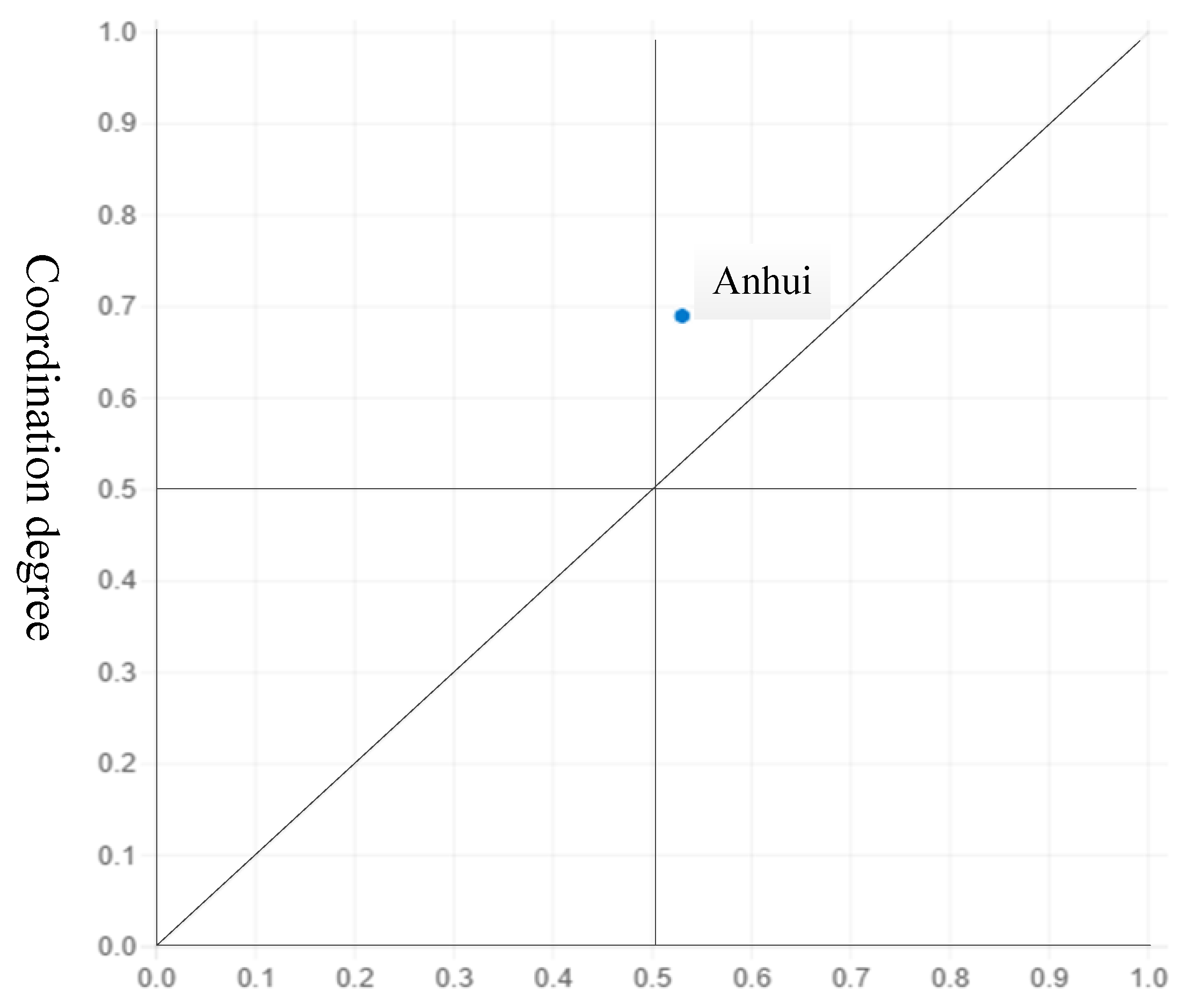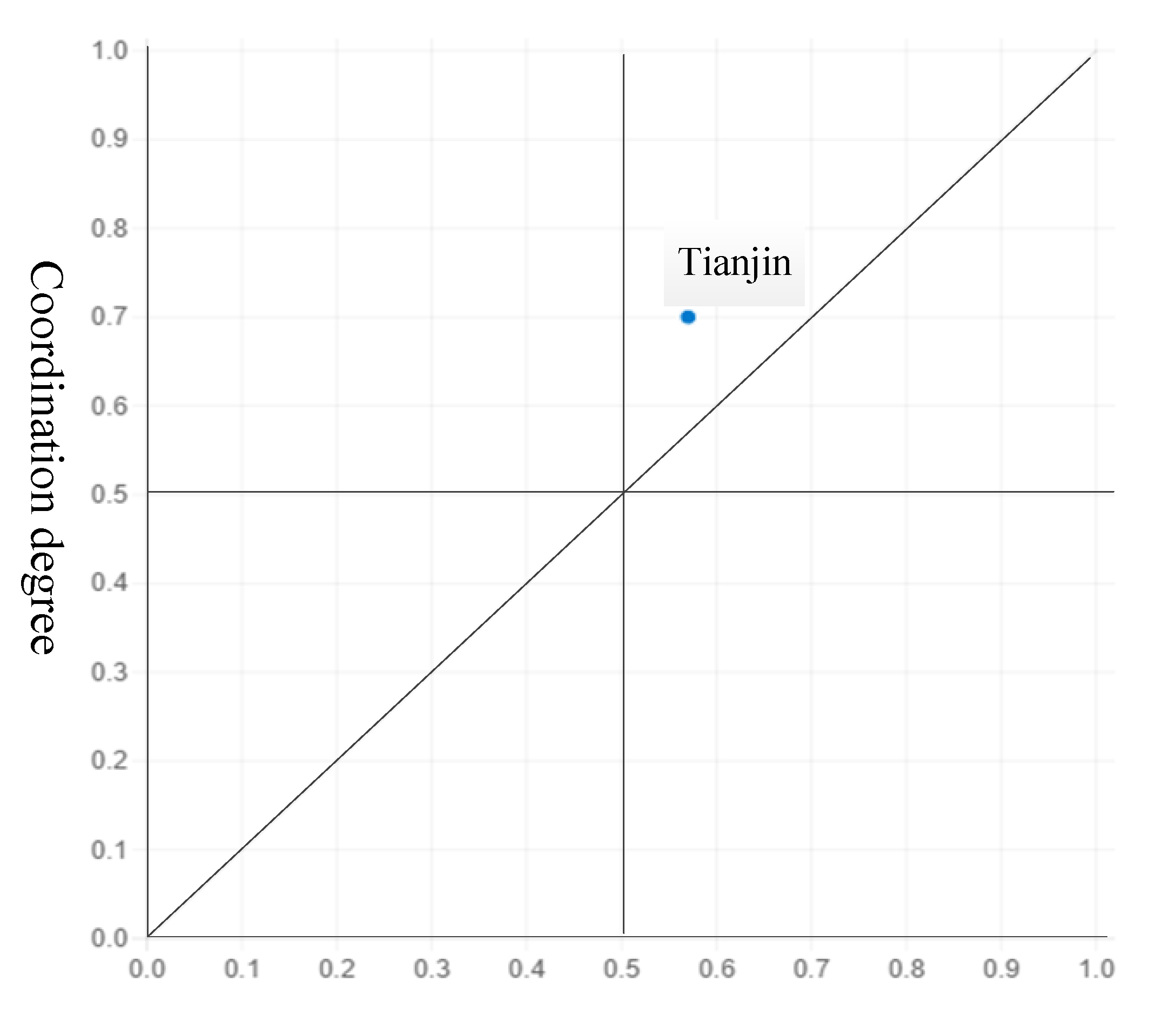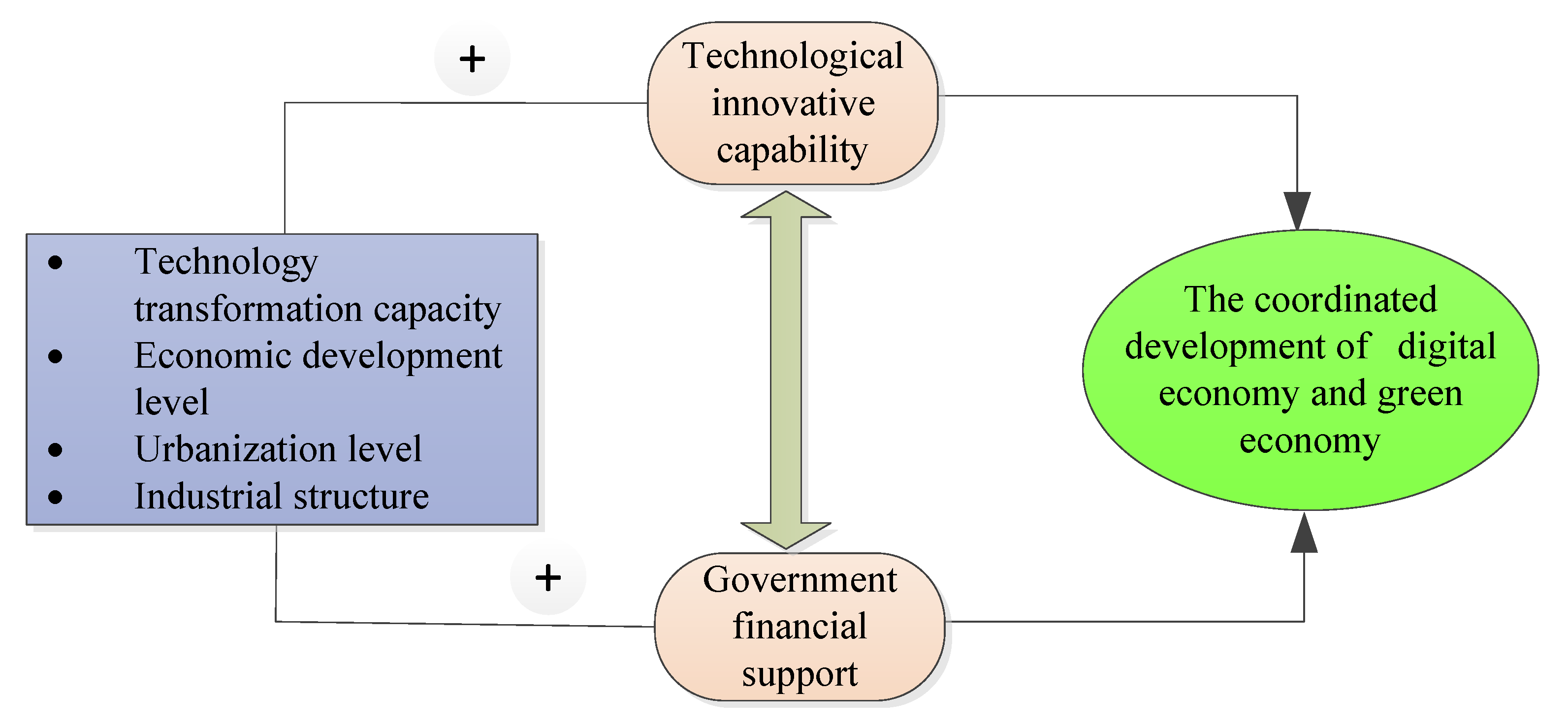4.3.1. Configuration Analysis and Typical Case Analysis
By running a truth table on the software fs/QCA 3.0, configurations of conditions for achieving a high coordination degree of the digital economy and green economy were obtained, as presented in
Table 6. The intermediate solution generated by the software operation was regarded as the realization path of the coordinated development of the digital economy and green economy, and the core conditions and peripheral conditions in each realization path were determined by comprehensively considering the intermediate solution and the parsimonious solution. In the analysis of configuration adequacy, we set the case frequency threshold as 1, and a more restrictive consistency threshold for the solution was chosen as 0.80, which exceeds the minimum recommended value of 0.75 [
54]. Meanwhile,
Table 6 also shows some parameters that describe the characteristics of each path, such as consistency, raw coverage, unique coverage, overall solution consistency, and overall solution coverage. Raw coverage is the proportion of cases that fit this configuration, unique coverage is the proportion of cases that fit only this configuration and no other configurations, and overall solution coverage explains the combined coverage of all cases.
Table 6 shows that there are five configurations of conditions (paths) to achieve the coordinated development of the digital economy and green economy: configuration H1, configuration H2, configuration H3, configuration H4, and configuration H5. Previous studies have proven that the acceptable standard of sufficient conditional consistency is 0.8 [
57,
69]. The consistencies of these five configurations all exceed 0.8, indicating that they are sufficient conditions for the coordinated development of the digital economy and green economy.
Under the joint action of multiple antecedents, the five configurations H1–H5 can all enable the coordinated development of the digital economy and green economy, and each configuration includes multiple antecedent conditions. This indicates that a single condition is not sufficient to achieve the coordinated development of the digital economy and green economy, and the configurations of the coordinated development of the digital economy and green economy have the characteristics of equivalence and multiple concurrency. The overall consistency of the five configurations is 0.9271, indicating that 92.71% of the regions that meet the five configurations have a high degree of coordinated development of the digital economy and green economy. Meanwhile, the overall solution coverage of these five configurations is 0.6726, indicating that these five configurations can explain 67.26% of the regions with coordinated development of the digital economy and green economy.
Configuration H1 (raw coverage of 0.2284 and consistency of 0.9660) shows that the presence of technological innovation capacity, government environmental regulations, economic development level, urbanization level, and the absence of technology transformation capacity and government financial support can achieve the coordinated development of the digital economy and green economy. This indicates that a region with high levels of technological innovation capacity, government environmental regulations, economic development, and urbanization, along with low levels of technology transformation capacity and government financial support, can achieve a high degree of coordination between the digital economy and green economy, in which these conditions all serve as the peripheral conditions.
Figure 2 shows that the regions that correspond to configuration H1 are Fujian and Chongqing. The Evaluation Report on China’s Regional Innovation Capacity (2021) shows that Chongqing and Fujian rank 12th and 13th among the 31 provincial-level regions in terms of innovation capacity, respectively. Strong technological innovation ability provides strong technical support for the coordinated development of the digital economy and green economy. Digital facilities adopt green technology, and digital technology promotes green transformation of the traditional economy. Chongqing and Fujian have a high intensity of environmental regulation, which provides a supporting tool for economic transformation towards green development. The high levels of economic development and urbanization in Chongqing and Fujian provide a foundation for the coordinated development of the digital economy and green economy.
Configuration H2 (raw coverage of 0.4199 and consistency of 0.9812) has the highest consistency, raw coverage, and unique coverage among all of the configurations, indicating that configuration H2 is the primary configuration for regions to achieve a high degree of coordination between the digital economy and green economy. Configuration H2 shows that high levels of technological innovation capacity, technology transformation capacity, economic development, urbanization, and industrial structure, along with low levels of government financial support, can together lead to the coordinated development of the digital economy and green economy, in which the economic development level, urbanization level, and industrial structure are the core conditions, while the other conditions are the peripheral conditions.
Figure 3 shows that the regions that correspond to configuration H2 are Beijing, Guangdong, Shanghai, Zhejiang, Shandong, and Liaoning, which are all located on the east coast of China. Rich universities, research institutes, and enterprises in these regions strengthen their technological innovation capability and technology transformation capacity. Moreover, these regions have high levels of economic development and urbanization, and their tertiary industry has been well developed, accounting for a relatively high proportion of regional GDP.
Configuration H3 (raw coverage of 0.1828 and consistency of 0.9446) shows that the combination of the presence of technological innovation capacity, technology transformation capacity, and industrial structure, in the absence of government financial support, government environmental regulation, economic development level, and urbanization level, can generate sufficient conditions for the coordinated development of the digital economy and green economy. This indicates that high levels of technological innovation capacity, technology transformation capacity, and industrial structure, along with low levels of government financial support, government environmental regulation, economic development, and urbanization, can lead to a high degree of coordination between the digital economy and green economy. In configuration H3, technological innovation capacity, government environmental regulations, and industrial structure serve as the core conditions, while the other conditions are the peripheral conditions.
Figure 4 shows that the typical case that fits configuration H3 is Sichuan, which is in the southwest of China. Sichuan has a large number of strong colleges and universities, providing it with strong technological innovation capacity and technology transformation capacity. In recent years, tertiary industry has developed into the leading industry in Sichuan; therefore, tertiary industry accounts for a relatively high proportion of Sichuan’s GDP.
Configuration H4 (raw coverage of 0.3034 and consistency of 0.9151) shows that the combination of the presence of technological innovation capacity, technology transformation capacity, government environmental regulations, and economic development level, in the absence of government financial support, urbanization level, and industrial structure, can lead to the coordinated development of the digital economy and green economy. This indicates that high levels of technological innovation capacity, technology transformation capacity, government environmental regulation, and economic development, along with low levels of government financial support, urbanization, and industrial structure, can together lead to a high level of coordinated development between the digital economy and green economy, in which technological innovation capacity, government environmental regulations, economic development level, and industrial structure are the core conditions, while the other conditions are the peripheral conditions.
Figure 5 shows that the typical case that fits configuration H4 is Anhui, which is located in the hinterland of central China. Anhui attaches great importance to innovation activities, and the R&D investment intensity there in the past two years has been more than 2%. According to the Evaluation Report of China’s Regional Innovation Ability, Anhui’s comprehensive innovation ability has been ranked among the top 10 in China in recent years, effectively promoting the development of digital technologies and green technologies. Anhui has strict environmental regulations and implements the third-party treatment of environmental pollution so as to improve the effect of environmental pollution control and effectively promote the development of the green economy. Moreover, the high level of economic development in Anhui provides a material guarantee for the coordinated development of the digital economy and green economy.
Configuration H5 (raw coverage of 0.1695 and consistency of 0.9405) has the lowest consistency, raw coverage, and unique coverage among the five configurations, which shows that configuration H5 is the rarest path for regions to achieve coordinated development of their digital economy and green economy. Configuration H5 shows that high levels of technology transformation capacity, government financial support, economic development, urbanization, and industrial structure, along with low levels of technological innovation capacity and government environmental regulations, can together lead to a high degree of coordination between the digital economy and green economy. In configuration H5, the economic development level, urbanization level, and industrial structure serve as the core conditions, while the other conditions serve as the peripheral conditions.
Figure 6 shows that the typical case that fits configuration H5 is Tianjin, which is located in the eastern coastal area of China, with good conditions for economic development. Although Tianjin’s technological innovation ability is weak, it has a strong technology transformation ability, with the advantage of being in the Beijing–Tianjin–Hebei region. Moreover, government financial support, high urbanization, and the leading development of tertiary industry provide prerequisites for the coordinated development of the digital economy and green economy.
Based on the TOE framework, the antecedent conditions for this study were selected from three aspects of technology, organization, and environment.
Table 6 shows that the five paths to achieving the coordinated development of the digital economy and green economy consist of conditions from different aspects of technology, organization, and environment. According to the characteristics of the antecedent conditions, the five configurations for achieving the coordinated development of the digital economy and green economy can be divided into two categories: technology–environment dual drive type (configurations H2 and H3), and technology–organization–environment linkage drive type (configurations H1, H4, and H5). In the technology–environment dual drive type (configurations H2 and H3), the high-level antecedent conditions all come from both technological and environmental aspects. Similarly, in the technology–organization–environment linkage drive type (configurations H1, H4, and H5), the high-level antecedent conditions come from three aspects of technology, organization, and environment.
